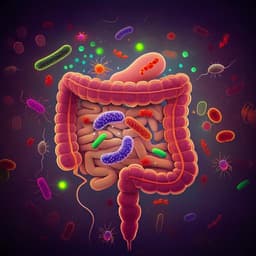
Biology
Gut microbiota determines the social behavior of mice and induces metabolic and inflammatory changes in their adipose tissue
O. Agranyomi, S. Meininger-mordechaï, et al.
Discover how gut microbiota influences social behavior in mice, revealing startling differences between dominant and submissive individuals. This groundbreaking research by Oryan Agranyomi and colleagues highlights a causal link between specific microbiota and behavioral traits, shedding light on the complex relationship between gut health and social dynamics.
~3 min • Beginner • English
Introduction
The study investigates whether distinct gut microbiota compositions are associated with and causally contribute to stable social behavior phenotypes—dominance (Dom) versus submissiveness (Sub)—in mice. Prior work implicates the gut–brain axis in modulating brain function and social behaviors, and social interactions influence well-being and disease risk. Stress, social defeat, and dietary interventions have been linked to alterations in gut microbiota and to anxiety/depressive-like behaviors. Inflammation and adipose tissue metabolism have also been associated with mood disorders, yet direct links between gut microbiome composition, adipose inflammation, and social behavior remain underexplored. Using a selectively bred Sabra mouse model that exhibits robust, stable dominant or submissive behavioral phenotypes, the authors hypothesize that Dom and Sub mice harbor distinct gut microbiota that shape social behaviors and, via inflammatory processes, alter epididymal white adipose tissue (eWAT) physiology. The study aims to characterize gut microbiota differences, relate them to adipose metabolic/inflammatory profiles and body weight, and test causality via fecal microbiota transplantation (FMT) into germ-free (GF) mice.
Literature Review
- Gut microbiota influences CNS function and behavior via metabolic, endocrine, immune, and neural pathways within the gut–brain axis. Studies show microbiota is essential for normal social development and that FMT from specific pathogen-free donors can increase sociability in GF mice. Social defeat stress and chronic mild stress correlate with decreased microbiota diversity and shifts in specific taxa, alongside anxiety- and depressive-like behaviors. Prebiotics can reduce anxiety-like behavior and improve social interaction in rodent models, with associated microbiota changes.
- FMT in GF animals can induce chronic inflammation and disease phenotypes, indicating causal roles for microbiota. Adipose tissue inflammation and metabolic disturbances have been linked to depression and mood disorders. However, a direct, integrative assessment connecting gut microbiota, adipose tissue inflammatory/metabolic status, and social behavior has been lacking.
- Prior reports in rodents and humans associate lower gut microbiota richness/diversity with stress exposure and psychiatric conditions (e.g., major depressive disorder), and specific taxa such as Rikenellaceae and reductions in Prevotella/Paraprevotella have been implicated in stress-related phenotypes and adipose inflammation.
Methodology
- Animals and behavioral model: Selectively bred Sabra mice exhibiting dominant (Dom) or submissive (Sub) phenotypes based on a dominant–submissive relationship (DSR) food-competition paradigm. Offspring from generations F24–F26 were used. Mice were maintained under 12-h light/dark cycles with standard chow and water ad libitum.
- Dominant–Submissive Relationship (DSR) test: Pairs of 8-week-old, sex-matched mice, weight-matched, were tested in a two-chamber apparatus connected by a tunnel with access to sweetened milk. After 14 h food deprivation and 30 min habituation, drinking time was recorded for 5 min across 4 consecutive days. Dominance was assigned if a significant difference (p < 0.05) and at least 40% difference in average drinking duration was observed.
- Longitudinal measures: Body weight tracked from 2 to 8 weeks of age; food intake recorded and normalized by cage average body weight.
- eWAT analysis: Epididymal white adipose tissue mass normalized to body weight measured in male mice. Histology performed on paraffin-embedded 4-μm sections stained with H&E; adipocyte diameters quantified using ImageJ from multiple fields. Macrophage infiltration assessed via F4/80 immunohistochemistry and F4/80 mRNA expression by qRT-PCR (normalized to HPRT).
- Adipokine profiling: Protein extracts from eWAT analyzed with a Proteome Profiler Mouse adipokine array (R&D Systems). Densitometry performed with ImageQuant TL; duplicates normalized to internal positive controls. UCP-1 mRNA expression quantified by qRT-PCR (HPRT as housekeeping gene).
- Microbiome profiling in Dom/Sub/BS mice: Fresh fecal samples collected, DNA extracted (QIAamp DNA Stool Mini Kit with homogenization). 16S rRNA gene V4 region amplified (515F/806R), libraries prepared, pooled equimolar, and sequenced on Illumina MiSeq at Bar-Ilan University. QIIME2 (v2019.4) used for demultiplexing (q2-demux), denoising/clustering (DADA2), alignment (MAFFT), phylogeny (FastTree), taxonomy assignment (q2-feature-classifier vs Greengenes 99%). Feature filtering removed rare taxa (<1% samples; <0.001% frequency). Alpha diversity calculated on a rarefied table (2600 reads/sample) using Faith’s PD with Kruskal–Wallis testing. Beta diversity assessed with weighted and unweighted UniFrac with PERMANOVA (999 permutations). Additional Bray–Curtis PCA and heatmaps generated in R/phyloseq.
- Fecal microbiota transplantation (FMT) into germ-free mice: Male GF Swiss Webster mice received a single oral gavage of pooled fecal suspensions from Dom donors (GF/Dom), Sub donors (GF/Sub), or PBS control (GF/Con). After adaptation, behavioral testing included: three-chamber sociability test (TCT), forced swim test (FST), and DSR (subset), conducted 28–35 days post-FMT. Subsequently, eWAT mass, histology, adipocyte size, and adipokine profiles were assessed. Gut microbiota of GF-transplanted mice analyzed by ZymoBIOMICS targeted 16S (V3–V4) sequencing on Illumina MiSeq.
- Gene expression: eWAT RNA extracted (QIAzol), cDNA synthesized (Promega), qRT-PCR (SYBR Green) for F4/80 and UCP-1, normalized to HPRT.
- Statistics: GraphPad Prism 6; data presented as mean ± SEM. Student’s t-test for pairwise comparisons; one-/two-way ANOVA with Bonferroni correction for multiple comparisons. Significance thresholds: * p < 0.05; ** p < 0.01; *** p < 0.001. LEfSe thresholds for genus-level differences: LDA > 2.0; p < 0.05.
Key Findings
- Behavioral phenotype: DSR test confirmed robust Dom–Sub differentiation; Dom mice exhibited significantly longer drinking time than Sub mice (Dom: 27.81 ± 3.26 s vs. Sub: 12.00 ± 0.72 s; p < 0.01).
- Growth and intake: From 2 to 8 weeks, Dom mice maintained significantly higher body weight than Sub mice (~1.15-fold; p < 0.001), despite similar chow intake (p > 0.05).
- eWAT differences: Sub mice had lower eWAT mass than Dom mice (~1.15-fold lower; p < 0.01). Adipocyte size was markedly reduced in Sub mice (reported 125-fold decrease; p < 0.05) with higher size heterogeneity. Macrophage infiltration in eWAT was increased in Sub mice (2.1-fold; p < 0.001), with elevated F4/80 gene expression (1.5-fold; p < 0.05) and crown-like structures evident histologically.
- Adipokine/metabolic profile: Of 38 adipokines assayed, 18 were significantly elevated in Sub eWAT versus Dom (p < 0.05). Only C-reactive protein was higher in Dom mice. UCP-1 mRNA expression was higher in Sub mice, suggesting increased thermogenesis/browning.
- Microbiota composition (Dom/Sub/BS): Sub mice had a distinct and less diverse gut microbiota compared to Dom and background strain (BS) mice. Beta diversity (unweighted UniFrac) differed significantly across groups (B5 vs. Sub p = 0.007; B5 vs. Dom p = 0.07; Dom vs. Sub p = 0.002). Sub microbiota uniquely included genera Mycoplasma and Anaeroplasma (Tenericutes/Mollicutes) and families Rikenellaceae and Clostridiaceae, and showed reduced abundance of Prevotella/Paraprevotella compared to Dom/BS.
- FMT causality: GF mice receiving Sub microbiota (GF/Sub) acquired Sub-like microbiota and displayed behavioral alterations consistent with Sub phenotype: impaired sociability in the three-chamber test (similar entries to empty and stranger chambers; p = 0.0157), and increased depressive-like behavior in FST. GF/Dom mice preferred the empty chamber over the stranger (p = 0.0086). DSR patterns were not robust in transplanted GF mice after a single pooled FMT.
- FMT physiological effects: GF/Sub mice had lower normalized eWAT mass than GF/Dom mice (30 ± 3% vs. 40 ± 1%; p = 0.0371), smaller adipocytes, and an adipokine profile resembling Sub donors, with multiple adipokines significantly elevated versus GF/Dom.
Discussion
The findings support a model in which gut microbiota composition contributes to stable social behavior phenotypes in mice and is linked to adipose tissue metabolic and inflammatory states. Dom and Sub mice, despite close genetic backgrounds, harbored distinct gut communities that aligned with their behavioral traits and body composition. Sub mice exhibited reduced microbiota diversity and unique enrichment of Mycoplasma/Anaeroplasma (Tenericutes) and Rikenellaceae/Clostridiaceae, together with reductions in Prevotella/Paraprevotella. These taxonomic signatures parallel observations in stress-exposed rodents and in humans with mood disorders, where lower diversity and altered Prevotella are reported.
Causality was supported by FMT: GF mice colonized with Sub microbiota adopted Sub-like social deficits and depressive-like behaviors, and mirrored Sub physiological traits—reduced eWAT mass, smaller adipocytes, increased macrophage infiltration, and elevated pro-inflammatory/metabolic adipokines (e.g., FGF21, VEGF), alongside increased UCP-1 expression suggesting enhanced browning/thermogenesis. This indicates that microbiota-driven signals can modulate adipose tissue inflammation/metabolism, which may, through immune-endocrine and metabolic pathways, influence brain circuits governing social and affective behaviors.
The work links social behavioral modes with microbiome composition and peripheral metabolic inflammation, suggesting that specific taxa and adipose-derived signals (adipokines) form part of a microbiota–adipose–brain axis affecting sociability and stress vulnerability.
Conclusion
This study demonstrates that distinct gut microbiota are associated with and can causally induce dominant versus submissive social behavior patterns in mice. Sub mice display a unique, less diverse microbiota with specific taxa (Mycoplasma, Anaeroplasma, Rikenellaceae, Clostridiaceae), lower body weight and eWAT mass, smaller adipocytes, and elevated inflammatory/metabolic adipokines and UCP-1 expression. Transferring Sub microbiota to germ-free mice reproduces Sub-like behavioral and physiological phenotypes, highlighting a microbiota–adipose–brain axis. Future research should identify mechanistic mediators (microbial metabolites, immune pathways, neural signaling), determine the roles of specific taxa, assess dose/chronology effects of repeated FMTs or defined consortia, evaluate sex differences and developmental windows, and explore translational potential for microbiota-targeted interventions to modulate social behavior and mood via adipose inflammation/metabolism.
Limitations
- FMT was performed as a single transplantation using pooled donor feces, which may dilute individual-specific microbial effects and reduce signal strength in behavioral assays (e.g., DSR).
- Potential exposure of fecal material to aerobic conditions could compromise anaerobe viability and alter transplant efficacy.
- DSR patterns were not robustly reproduced in GF mice post-FMT, suggesting that either multiple transplants, longer colonization, or non-pooled donors may be needed to fully transfer this specific trait.
- GF transplantation experiments used male mice, limiting assessment of sex-specific effects.
- Selectively bred Sabra lines may limit generalizability to other strains or species.
- Some microbiota diversity and ASV count reporting in the text appears inconsistent; sequencing/platform differences between conventional and GF cohorts (different labs/kits) could introduce batch effects despite analysis controls.
Related Publications
Explore these studies to deepen your understanding of the subject.







